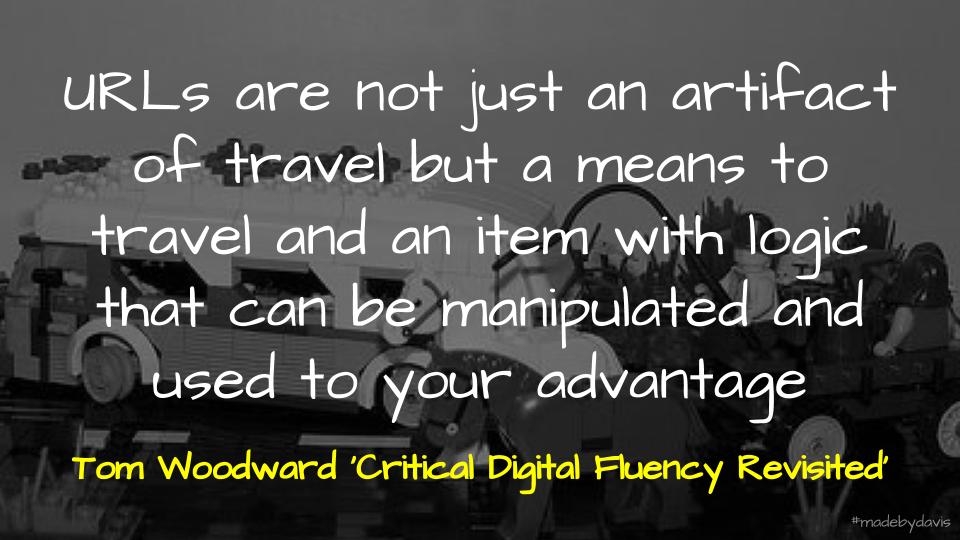Maybe there were some things that I would have changed, however considering the current state of things, I was again pretty lucky this year.
Personally, our children have continued to grow up. The youngest has progressed from learning how to climb the ladder to get on the trampoline to now utilising a range of objects to seemingly climb anything. Nothing is out reach as I learnt when she poured my coffee all over her resulting in an ambulance trip. Our eldest also had a trip to the emergency after standing on glass. It is moments like this that I am reminded how lucky I am living in Australia to have access to a quality public health system (although we do have private cover as well.) We also went on a couple of trips, including a couple of weeks in New Zealand and a weekend in Warrnambool.
At work, I saw my role change from that of a technology coach to becoming a ‘subject matter expert’. I think when you are working within an agile project you do what needs to get done. This has included:
- Working collaboratively in the creation of a series of online modules
- Exploring ways to automate the creation of school timetables
- Leading the deverlopment of a biannual reporting solution with the help of Tom Halbert
- Comparing different models for online learning hubs
- Increase understanding data literacy
I have enjoyed the challenges associated with my job this year, however I must say that I miss working with students and teachers. Being removed from the school environment, it can be strange telling people that I am an educator.
With my learning, I presented at two EdTechTeam Summits, the National Coaching Conference and EduChange17. I was lucky enough to be invited to present on flipped learning.I also met a few more connected educators in real life, such as Darrel Branson, Alan Levine, Richard Wells and Andrea Stringer.
In regards to my writing and thinking, I would saying that there are three themes that have existed across my posts this year:
TRANSFORMATION
I have wondered a lot about the complexities and parts associated with change and transformation in Education. Whether it be the conditions that are created or the questions we ask.
WORKFLOWS
I have explored different ways of working and improving digital workflows, whether it be automating the creation of timetables and the summary of data. smartphone. I have tinkered with a better web. This included spending a month in Google+, participating in #DigCiz and exploring some of the obstacles associated with blogging. I have also developed new spaces, such as Wikity and a site for re-claiming my online presence.
APPLICATIONS
I continued to reflect on the feautres and affordances of various applications, such as Google Drawings, Google Sheets, Facebook Pages, Google’s Explore Tool, YouTube and Global2 . I also wrote some curated posts on portfolio platforms and ongoing reporting.
In regards to my newsletter, here are some of the posts that left me thinking this year:
Learning and Teaching
Establishing a culture of inquiry through inquiry – Kath Murdoch encourages teachers to begin the year with questions that can then be the start of a short inquiry, rather than the usual regimented style. For Edna Sackson this involves starting with the child. Sometimes the challenge with inquiry, as Sam Sherratt points out, is having permission.

Inquiry into Inquiry by mrkrndvs is licensed under CC BY-SA
Why I Hate Classroom Themes – Emily Fintelman reflects on classroom themes and wonders what impact they are really having on learning. She suggests that our focus should be on how spaces are structured and strategies that can be used to give students more voice.

Classroom Themes by mrkrndvs is licensed under CC BY-SA
The skill, will, and thrill of Project Based Learning – Bianca Hewes reflects on here experiences with Visible Learning and Project Based Learning. She highlights the similarities, such as a focus on stages and structure. The post finishes with a call to work together to strive for a better education for all. It is interesting reading this alongside the David Price’s analyses and a useful introduction to Project Based Learning.

PBL vs VL by mrkrndvs is licensed under CC BY-SA
Why Journalism Might Actually Be the Class of the Future – John Spencer suggests that the true makerspaces are found in creating texts, an activity best captured by journalism. To support this, Spencer provides a range of practical suggestions to turn every student into a budding journalist. This reminds me of Michael Caulfield’s writing about creating the web and connecting ideas. I wonder how it fits with the Digipo project and whether domain of one’s own is the greatest form of journalism?

Journalism by mrkrndvs is licensed under CC BY-SA
This free course can teach you music programming basics in less than an hour – Quincy Larson discusses Ableton’s free interactive music course that runs right in your browser. Having taught music a few years ago, I found this as a much more engaging method of grappling with the different principles of music in an interactive way.
If you enjoy listening to music, but don’t know much about how it all works on a structural level, this course is for you. It will teach you some of the principles at work in popular songs like Queen’s “We Will Rock You” and Björk’s “Army of Me”.
Catch the Flipgrid fever! 15+ ways to use Flipgrid in your class – Kayla Moura provides an introduction to Flipgrid, an application for visual feedback. To support this, she lists some potential uses, such as a debate, an exit ticket or a book report. In some ways it reminds me of Verso and the way that users can share and respond in a centrally managed space. The main difference is that Flipgrid is built around video.
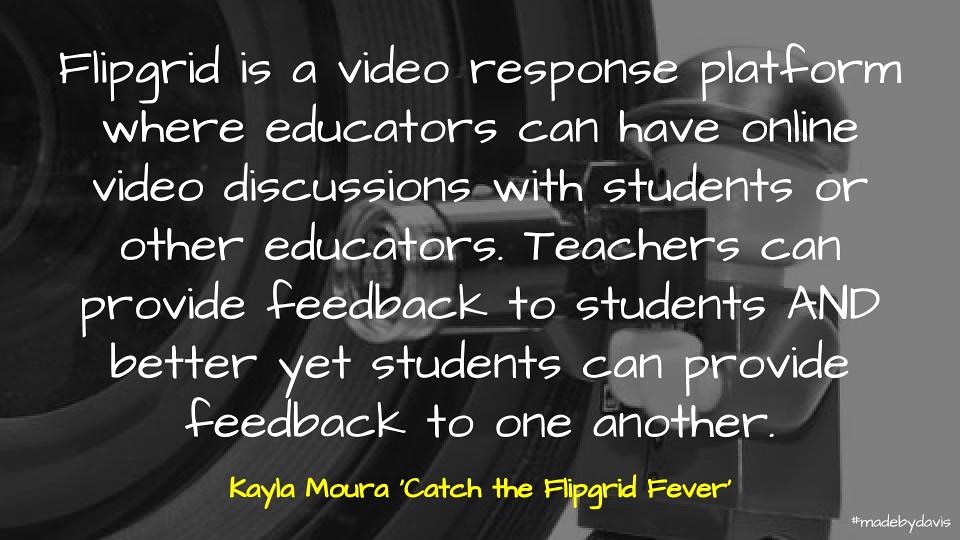
Catch the Flipgrid Fever by mrkrndvs is licensed under CC BY-SA
Here (with 2 Years of Exhausting Photographic Detail) Is How To Write A Book – Ryan Holiday unpacks the process involved in developing a book, from the initial proposal to the published copy. This lengthy reflection is a great example of ‘showing your work’. Holiday shares a number of tips, such as recording quotes and ideas on notecards, as well as breaking the book into smaller chunks. It is a reminder of the time and effort involved in developing quality writing, something Mike Caulfield touched on.

Ryan Holiday ‘Here (with 2 Years of Exhausting Photographic Detail) Is How To Write A Book’ by mrkrndvs is licensed under CC BY-SA
Using ‘Visitors and Residents’ to visualise digital practices – David White and Alison Le Cornu have published a paper continuing their exploration of digital belonging and the problems with age-based categorisations. One interesting point made was the blur that has come to the fore between organisations and individuals. It is interesting to consider this model next to White’s work in regards to lurkers, as well as the ability to ‘return the tools’ without inadvertently leaving some sort of trace.

‘Using Visitors and Residents to visualise digital practices’ by mrkrndvs is licensed under CC BY-SA
Asking the right questions – Alice Leung unpacks a range of question types and their place in the classroom, including no hands up and higher order. I have written about questions in the past, while Warren Berger’s book A More Beautiful Question is also an interesting provocation.

Asking the Right Question by mrkrndvs is licensed under CC BY-SA
Twist Fate – The Connected Learning Alliance challenged teens to pick a classic story and create an alternate scenario through art or story where a famous hero is the villain or an infamous villain, the hero, with the finalists collated in a book. For further insight into the project, Sara Ryan and Antero Garcia provide a reflection on the some of the stories and the project.

Twist Fate @mizuko by mrkrndvs is licensed under CC BY-SA
How colonial violence came home: the ugly truth of the first world war – Pankaj Mishra pushes back on the myth that World War I was largely a white European affair, instead suggesting that it was the moment when violent imperial legacies returned home. Along with Nafeez Ahmed’s reflection on Thanksgiving, these critiques remind us of the many forgotten voices during memorial days and national celebrations. Interestingly, TripleJ have decided to move the Hottest 100 Count from Australia Day, ‘a very apprehensive day’ for the Indigenous people of Australia. This is all a part of what Quinn Norton describes as ‘speaking truth’ against racism.
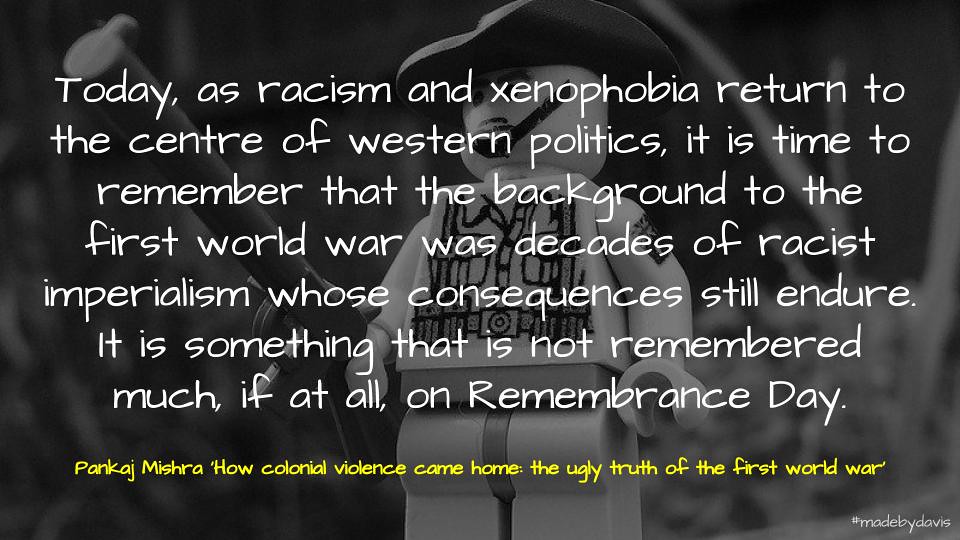
How colonial violence came home: the ugly truth of the first world war by mrkrndvs is licensed under CC BY-SA
Use Maps & Mapmaking in Your ELA Classroom – Kevin Hodgson discusses the power and potential of maps in extending comprehension and representing understanding. I have written before about visualisation before, however Hodgson’s post provides a range of ideas I had not considered.

@Dogtrax on Maps by mrkrndvs is licensed under CC BY-SA
Edtech
Don’t Blame the Tools – Jose Picardo points out that blaming technology overlooks that the tool is only one part of the pedagogical canvas. I think things like SAMR can confuse the conversation. Instead, we need to start with a wider discussion of education.

‘Don’t Blame the Tools by mrkrndvs is licensed under CC BY-SA
Against Expressive Social Media – Mike Caulfield makes the case to break with our dependence on the social media generated dopamine hits to develop the type of critical collaboration needed for the future. Reflecting on his own history of the web, Caulfield suggests that we need new ways of working that challenge our collective thinking, not just confirm our biases. Along with Audrey Watters’ post on edtech in the time of Trump, these posts ask many questions to address for a different imagining of educational technology and a democratic society. It also provides a useful background to the intent beyond such tools and technology as Hypothes.is, Wikity and Smallest Federated Wiki.

Against Expressive Social Media by mrkrndvs is licensed under CC BY-SA
Dear Twitter. It’s not me, it’s you – David Hopkins reflects on some of the changes that have occurred lately within Twitter, both socially and technically. There seems to be a lot of talk around Twitter of late, whether it be around alternatives, possible changes or how it is being unbundled.

On Twitter by mrkrndvs is licensed under CC BY-SA
Reconceptualising Online Spaces To Build Digital Capacity – In notes from a webinar Naomi Barnes presented, she explores the question of integrating digital technologies. Building on the work of Marshall McLuhan, she discusses the idea of dialectics. This reminds me of Belshaw’s eight elements of digital literacies. Along with Jonathan Wylie’s presentation on good technology integration, these posts offer some alternatives to the usual reference to the SAMR model as the solution to talking about technology.

Technology by mrkrndvs is licensed under CC BY-SA
What should teachers understand about the snapchat back-channel? – Benjamin Doxtdater questions the place of Snapchat and other such backchannels in the classroom. Sachin Maharaj goes a step further to calling for it to be actively banned. For Steve Brophy, this is about waterholes. This takes me back to the question about what sort of teacher you are: limiters, enablers and mentors. However, as Bill Fitzgerald’s investigation into Edmodo demonstrates, there is also an ethical side to be considered. This was also highlighted by Twitter’s changes to privacy.

Benjamin Doxtdater ‘What should teachers understand about the snapchat back-channel?’ by mrkrndvs is licensed under CC BY-SA
A Sociology of the Smartphone – Adam Greenfield shares a portion of his new book, Radical Technologies, unpacking smartphones. In this assemblage of parts he looks at what actually makes smartphones work, the changes they have brought to our habits and the impact on our environment. On this matter, Kin Lane documents the valuable bits in a smartphone that everyone wants, Doug Belshaw discusses email and notification literacy, Aral Balkan asks who owns the data, while Mike Caulfield rues the impact smartphones have had on research. Greenfield’s essay also serves as an example of how technology can construct a ‘templated self’. This is timely with the tenth anniversary of the iPhone. In another extract from Greenfield’s book, he reflects on the internet of things.

A Sociology of the Smartphone by mrkrndvs is licensed under CC BY-SA
I Deleted All But The Last Six Months Of My Gmail – Kin Lane describes his process of taking back control of his digital bits from the algorithms. He is doing this by deleting archived data often used to develop marketing profiles. In addition to Gmail, he has documented cleaning up Facebook and Twitter. Lane and Audrey Watters also discuss this further on Episode 62 of the Contrafabulists podcast. Coming at the problem from a different perspective, the Guardian Tech Podcast discussed the new movement of platforms designed to support people in archiving their digital memories and moments.
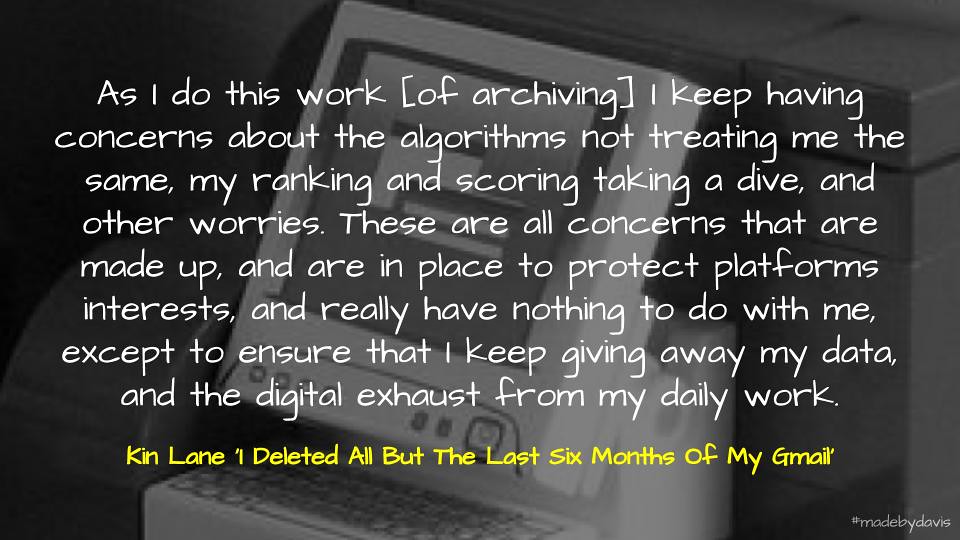
Kin Lane ‘I Deleted All But The Last Six Months Of My Gmail’ by mrkrndvs is licensed under CC BY-SA
What Do You Want to Know about Blogging? – Silvia Rosenthal Tolisano responds to number of questions about blogging, such as how to start out in the classroom, setup precautions, develop a habit and extend your thinking beyond the simple view of blogging. Kathleen Morris’ post on why every educator should blog, Marina Rodriguez’ tips for student blogging and Doug Belshaw’s guide how to write a blog post add to this discussion.

What Do You Want to Know about Blogging? by mrkrndvs is licensed under CC BY-SA
Why RSS Still Beats Facebook and Twitter for Tracking News – David Nield provides an introduction to RSS and why it can be better than social media for consuming content. One of biggest benefits is that it is unfiltered by the stacks. Nield provides some strategies for working with RSS, such as IFTTT and feed readers. Alan Levine lifts the hood on RSS, explaining how it works and what OPML is, while Bryan Alexander states why he decided to rededicate himself to RSS reading. In the end, it comes back to Doug Belshaw’s question of curating or being curated?

RSS Still Beats FB by mrkrndvs is licensed under CC BY-SA
We Are All Using APIs – Kin Lane explains how APIs are a part of our daily existence. Although we may not be able to do APIs, we need to be aware that they are there and what that might mean. This focus on the ethical as much as the technical relates to Maha Bali’s post about adding humanity back to computer science and Ben Williamson’s call to explore the social consequences associated with coding. Providing a different take on the ‘Hour of Code’, Gary Stager explains that the epistemological benefit of programming comes over time as we build fluency.

We Are All Using APIs @APIEvangelist by mrkrndvs is licensed under CC BY-SA
Learning Machines – Ben Williamson takes a dive into machine learning. He breaks his discussion down into three key areas: algorithms, hypernudges and personalised learning. Associated with this, Williamson also wrote about wearable brainwave training. Approaching this from the perspective of automating education, Naomi Barnes provides her own thoughts and reflections.
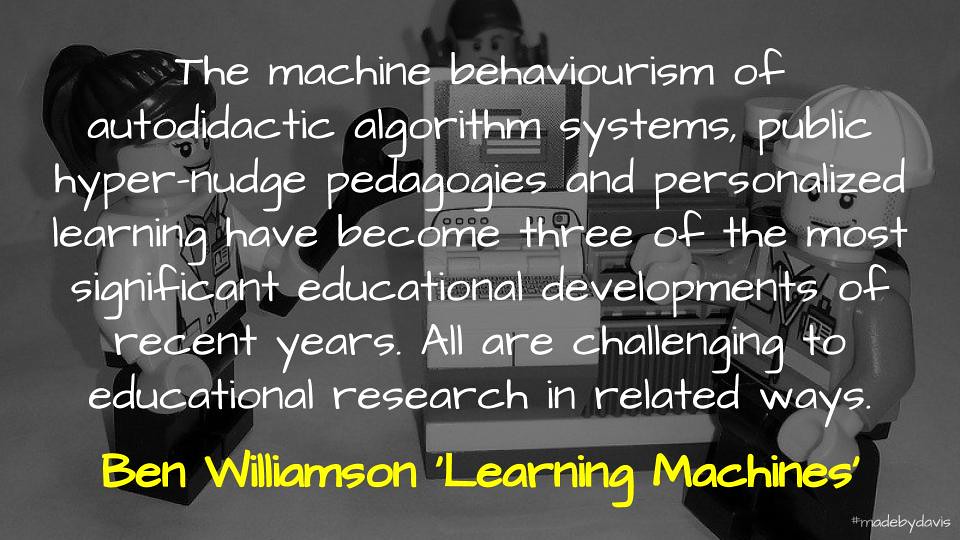
Learning Machines by mrkrndvs is licensed under CC BY-SA
Storify Bites the Dust. If You Have WordPress, You Don’t Need Another Third Party Clown Service – Alan Levine reflects on Storify’s announcement that it will be shutting down. He provides a number of options of what to do, including downloading the HTML content and stripping the links from it. This is a reminder why #IndieWeb and owning your content is so important

Storifried by mrkrndvs is licensed under CC BY-SA
Storytelling and Reflection
Media, Technology, Politics – Data & Society: Points – In light of technology, fake news and democracy, a group of researchers led by danah boyd have applied their thinking to a range of issues with some attempt to make sense of the current state of being in the US (and the world at large).

‘Did Media Literacy Backfire? by mrkrndvs is licensed under CC BY-SA
Will the AFLW herald changing times for gay players in the men’s game? – Kate O’Halloran reflects on first openly gay AFL players and wonders whether this will bring about a change in the men’s game. I have been left wondering what other impacts that the women’s competition might have on AFL and women’s sport in Australia in general. All of the sudden women are not only playing prime time, but also getting involved off the field in areas such as commentary as experts. In a sport that has seemingly pushed women to the margins, I am left wondering what impact AFLW will have on such jocular institutions as The Footy Show? As a father of two daughters it leaves me with hope.

Changing Times by mrkrndvs is licensed under CC BY-SA
Clash Of Ideas: The Tension Of Innovation – David Culberhouse outlines the importance of tension to foster innovation. Coming back to the ‘learning well’, he highlights the importance of difference and the way in which heavily managed environments undermine this.

Clash of Ideas @dculberhouse by mrkrndvs is licensed under CC BY-SA
Collaboration – Gary Stager considers all the hype surrounding Google Docs and it’s collaborative edge. In discussing his decades of experience, he suggests that writing is selfish and collaboration should not be forced, rather it needs to be natural. Along with Peter Skillen’s reflections on technology, these posts offer a useful provocation in thinking about modern learning.

Collaboration by mrkrndvs is licensed under CC BY-SA
No Me Without Us: Reflections After the UNIR #SelfOER #OpenTuesday Webinar – Reflecting on the call in regards to OER, Maha Bali discusses some of the challenges associated with the privilege around sharing. This is a continuation of a discussion around OER as a way of being.

@BaliMaha ‘No Me Without Us’ by mrkrndvs is licensed under CC BY-SA
Tweeting and blogging: Selfish, self-serving indulgences? – Responding to Clare Narayanan and her critique of the guru teachers who spend their time at Teachmeets and on Twitter, Deb Netolicky discusses finding balance between self care, family time and service to the profession. This is a reminder that being online is a choice with consequences. Something Claire Amos touches upon. Benjamin Doxtdater also suggests, maybe our primary focus should be on self-care and private journals.

Tweeting and blogging: Selfish, self-serving indulgences? by mrkrndvs is licensed under CC BY-SA
Competition – Dale Pearce highlights three key factors involved in creating a culture of competition in Australian schools: increased funding to non-government schools, public reporting to celebrate ‘winners’ and residualisation of public education. None of these aspects have been addressed with Gonski 2.0, (although Gonski has been brought on to help identify what practice works best.) To me, this is a part of a wider conversation about education, involving issues such as managing stress, providing the appropriate support, dealing with the rise of digital abuse, working together as a system and engaging with what it actually means to be a teacher.

Competition in Education by mrkrndvs is licensed under CC BY-SA
#rawthought: On Ditching the (Dangerous) Dichotomy Between Content Knowledge and Creativity – Amy Burvall explains that the key to joining the dots is having dots to join in the first place. Reflecting on the dichotomy between creativity and critical thinking, Burvall illustrates arts dependency on knowledge and skills. The challenge is supporting students in making this learning experience stick. Deb Netolicky also discusses some of these points in here discussion of ‘21st Century Learning’, while Bill Ferriter questions what comes first.
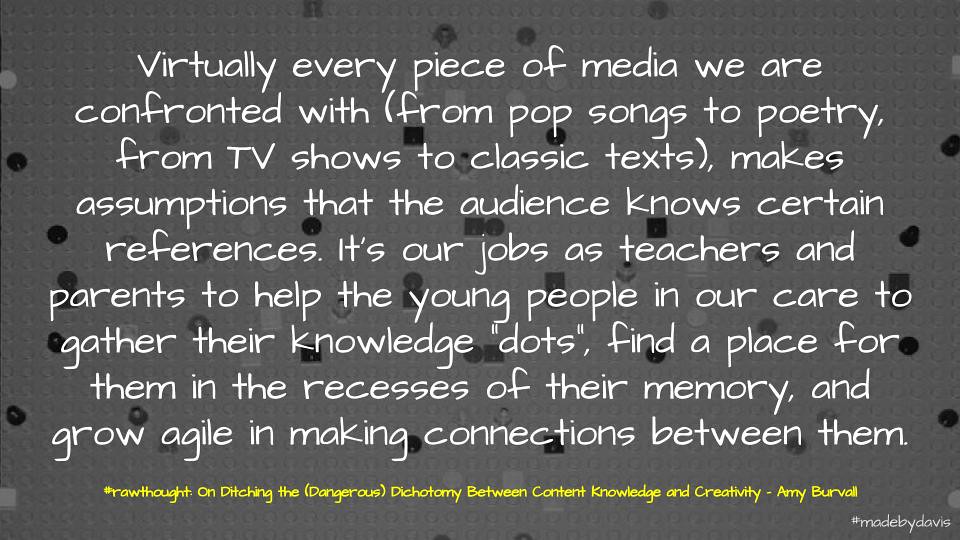
On Ditching the (Dangerous) Dichotomy Between Content Knowledge and Creativity @amyburvall by mrkrndvs is licensed under CC BY-SA
Tackle Workload. This bandwagon actually matters – Tom Sherrington discusses the problem of workload piled on the modern teacher. He highlights a number of elements to reconsider, such as report comments and pointless assessment. Considering the problem from the perspective of the teacher, Jamie Thom advocates becoming a minimalist and cutting back. Steve Brophy suggests looking after our own wellbeing by putting on your oxygen mask first. One thing that matters is our own development.

Tackle Workload by mrkrndvs is licensed under CC BY-SA
Should men or society stop the Harvey Weinstein’s of this world – Marten Koomen explores where to now with Harvey Weinstein and the way women are treated in society. He suggests that we need a collective effort by government to develop legislation and policy. Along with Rebecca Solnit’s post on blaming women for men’s actions and Julian Stodd’s investigation of the wider cultural problem brought out in the #MeToo movement, they touch on a wider problem around gender and inequality. On the Gist podcast, Mike Pesca discusses the challenges associated with reporting such topics. Jenny Listman adds a reminder that such power is abused by regular people too.

Should men or society stop the Harvey Weinstein’s of this world @Tulip_education by mrkrndvs is licensed under CC BY-SA
Bias Thwarts Innovation – Harold Jarsche explains why gender equity is so important when fostering a culture of innovation as it provides more dots to connect. This is a clarification of an initial post Jarsche wrote about our networked future. I have touched on the importance of gender equity before. Julian Stodd also wrote a useful post that breaks innovation down into six ‘thoughts’.

Bias Thwarts Innovation by mrkrndvs is licensed under CC BY-SA
Excuse Me While I “Just” Go Innovate – Pernille Ripp pushes back on continual call to just innovate, arguing that she innovates every day when she teachers, plans and contacts home. The problem is that these things do not count as innovative in many experts eyes. Bill Ferriter adds his own take on the reality of the classroom teacher, explaining that he does not check his emails during the day, that he is responsible for a range of people and that working with children is his number one priority. It is interesting to compare this with the discussion between Will Richardson and Bruce Dixon on the Modern Learners podcast in regards to the failure of teachers to engage with learning how to learn, as well as Richardson’s call from a few years back that the system is broken. For more on Ripp’s work, read Jennifer Gonzalez’s profile.

Just Innovate by mrkrndvs is licensed under CC BY-SA
FOCUS ON … Books
I did not read as many books this year, but here those that I did:
So that was 2017 for me, what about you? Who have been the voices that have stood out for you this year? As always, comments welcome.
If you enjoy what you read here, feel free to sign up for my monthly newsletter to catch up on all things learning, edtech and storytelling.
